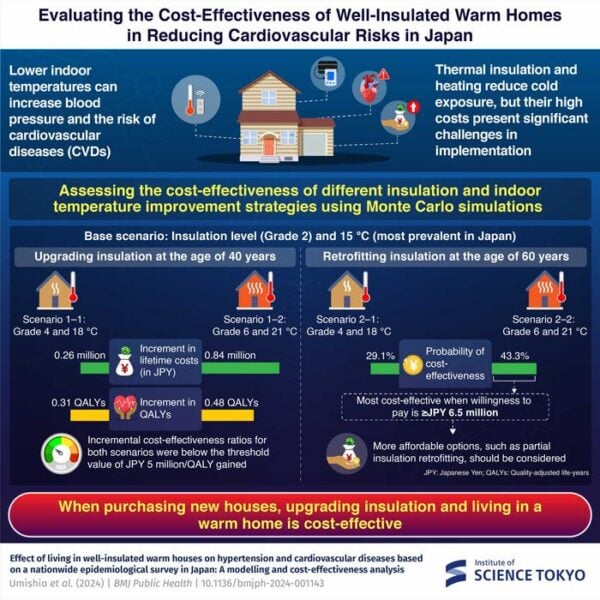Summary: A groundbreaking study from the Institute of Science Tokyo reveals that investing in better home insulation could significantly reduce cardiovascular disease risk and extend healthy life expectancy. The research shows that upgrading insulation in new homes is a cost-effective strategy for health improvement, potentially adding nearly half a year of healthy life for couples.
Journal: BMJ Public Health, September 24, 2024, DOI: 10.1136/bmjph-2024-001143
Reading time: 4 minutes
The Cold Truth About Japanese Homes
In Japan, a concerning health crisis is quietly unfolding behind closed doors. Over 90% of homes have indoor temperatures below 18°C – the minimum recommended by the World Health Organization. This cold environment isn’t just uncomfortable; it’s potentially dangerous for cardiovascular health.
Assistant Professor Wataru Umishio from Institute of Science Tokyo, who led the research, explains: “In Japan, a rapidly aging country, over 90% of homes had indoor temperatures below 18°C, which is the level recommended by the World Health Organization. Since older adults are more vulnerable to low temperatures and at a higher risk for CVDs, there is an urgent need to address housing and health issues here.”
A Groundbreaking Investigation
The research team developed an innovative economic model to understand how home temperature affects cardiovascular health. They created five different scenarios, comparing homes with various levels of insulation and tracking their impact on health and costs over residents’ lifetimes.
Using advanced computer simulations, they followed 100,000 virtual married couples through different housing scenarios. The results were striking: couples living in better-insulated homes gained up to 0.48 quality-adjusted life years (QALYs) – nearly half a year of healthy life.
Investment That Pays Off
While upgrading insulation does require initial investment, the study found that much of this cost is recovered through reduced medical expenses. In fact, for homes with moderate insulation improvements, 74.1% of the insulation costs were recovered through healthcare savings.
The findings suggest that installing better insulation when purchasing a new home is more cost-effective than retrofitting an older home. However, the researchers note that partial insulation retrofitting could still be a viable option for existing homes.
Technical Terms Glossary
Cardiovascular Disease (CVD): Conditions affecting the heart and blood vessels, often influenced by factors like blood pressure.
Quality-Adjusted Life Years (QALYs): A measure that combines both the length and quality of life gained through health interventions.
Thermal Insulation: Materials or systems used to reduce heat transfer between the inside and outside of buildings.
Hypertension: High blood pressure, which can be triggered or worsened by cold temperatures.
Test Your Knowledge
1. What percentage of Japanese homes have indoor temperatures below WHO recommendations?
Answer: Over 90%
2. How many additional quality-adjusted life years did the best-insulated homes provide for couples?
Answer: 0.48 QALYs
3. What percentage of insulation costs were recovered through reduced medical expenses in moderately insulated homes?
Answer: 74.1%
4. What is the WHO-recommended minimum indoor temperature?
Answer: 18°C
Enjoy this story? Get our newsletter! https://scienceblog.substack.com/
If our reporting has informed or inspired you, please consider making a donation. Every contribution, no matter the size, empowers us to continue delivering accurate, engaging, and trustworthy science and medical news. Independent journalism requires time, effort, and resources—your support ensures we can keep uncovering the stories that matter most to you.
Join us in making knowledge accessible and impactful. Thank you for standing with us!

